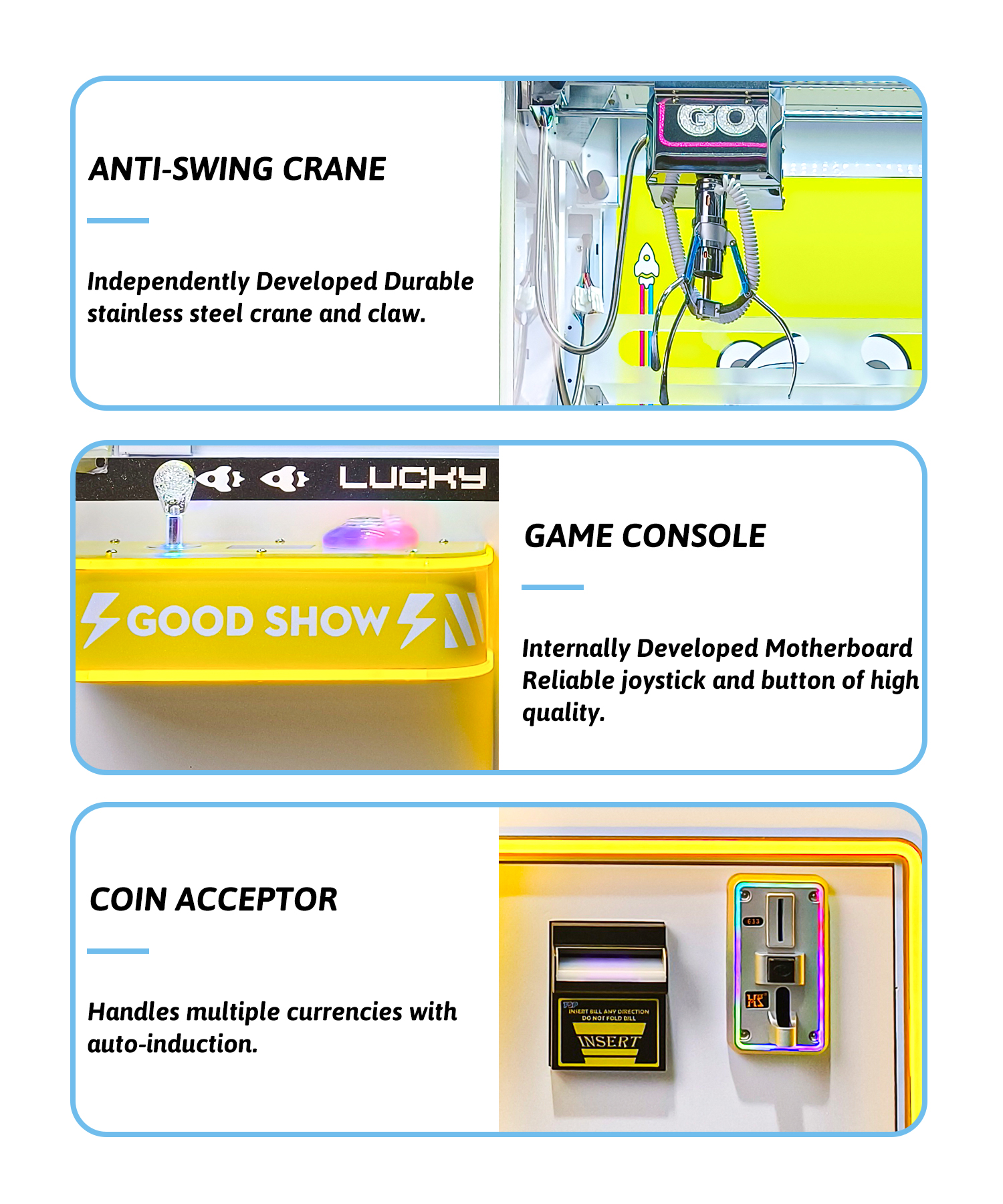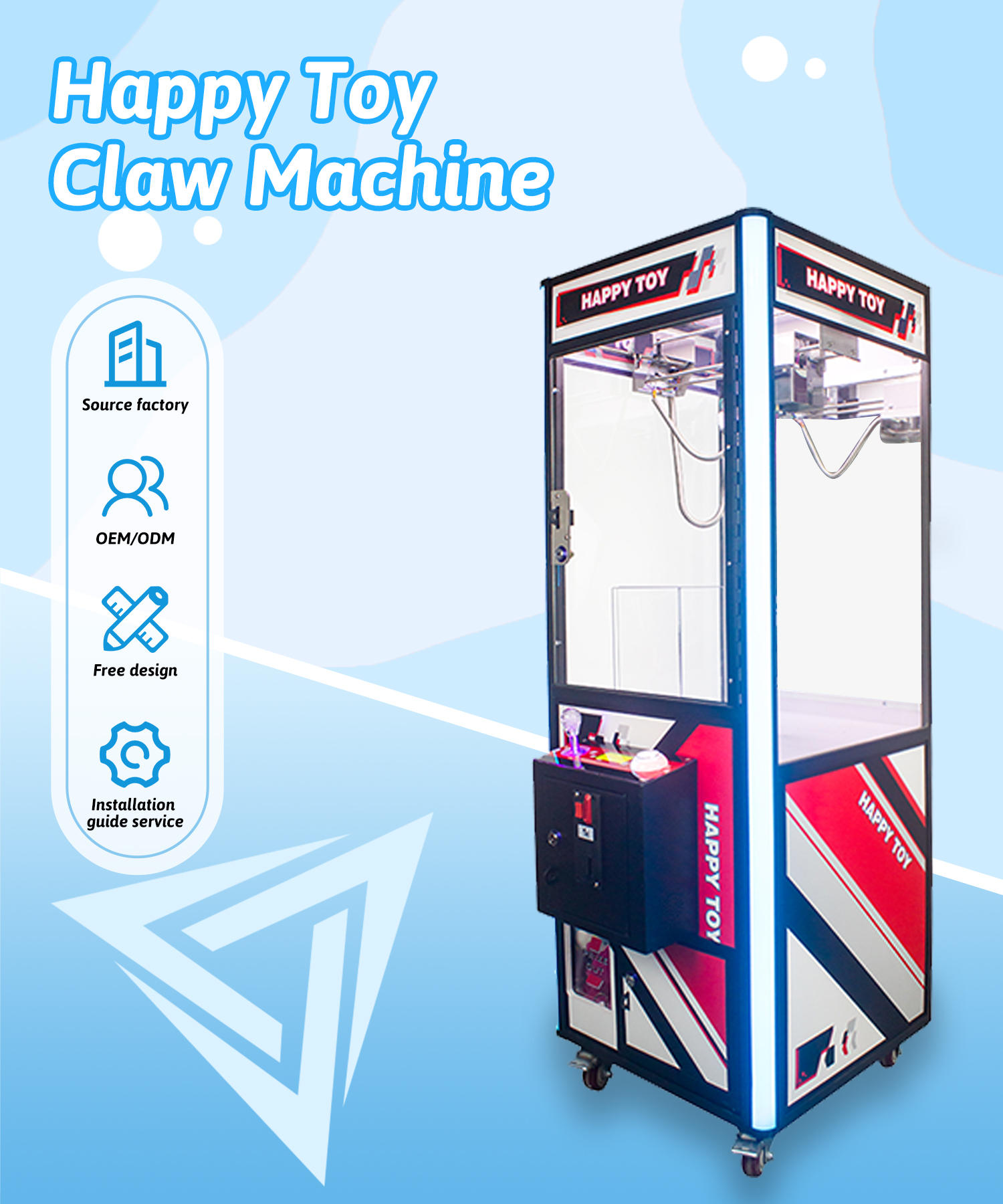Table of Contents
ToggleRevenue Factors
In the right conditions, claw machines, found frequently in malls, arcades and also in restaurants, can be extremely profitable. The income from these machines rests on several factors that any operators should into head to maximize their revenue.
Player Traffic and Location
The location of a claw machine greatly affects its income. Places like movie theatres, shopping malls, tourist areas, etc. provide higher plays per machine trend. For instance, a machine at the entrance of a bustling arcade may have a few hundred pays per week, each added to up the income.
Cost and Type of Prizes
The nature and cost of the prizes can significantly affect both the appeal of the machine and the profit margins. Affordable yet attractive prizes like popular toys, electronic gadgets, and licensed merchandise can lure more players. However, the cost must be carefully managed to ensure profitability. Typically, the value of the prizes should be less than 25% of the revenue per play to maintain healthy margins.
Pricing Strategy
The amount per play charged which is a direct income factor. Some locations may model their pricing on a $1 or $2 to play basis, depending on the region and such, while still reflected on the perceived prizes’s value. Changing prices is also a way to make a tactical response to how people are interacting with your game and how that affects profitability. For example, dropping the price during off hours or off days can help increase the volume of plays.
Attractiveness and Maintenance of the Machines
More players are drawn to a well-kept, clean piece of equipment. Routine upkeep ensures the machine works accurately and keeps revenue from disaster strikes caused by machine downtime, On top of that, machines equipped with high-tech features such as LED lighting or unorthodox designs can also help them get noticed.
Promotions and Marketing
Tactics to get the gears turning and the binge-watching in full flow. By adding a period of time in which a win is guaranteed or a discount when entering multiple times, offers can encourage visitors to stand a better chance of walking away as winners and increase revenue. Good machine placement, especially in spots with lots of other entertainment options, is key to drive traffic to the claw.

Cost Analysis
It is essential to understand the cost structure of running claw machines in order to make the most money out of it. These costs depend heavily on the location of the machine, what kind of prizes are offered, and how often it is repaired.
Initial Investment and Setup
A claw machine to purchase often costs somewhere between $2,000 and $5,000 depending on the model, and the features included. From cost of shipping to installation, as well fidelity to the Theme or Branding of your venue. The setup costs are a very important upfront investment that deserves some careful review.
Prize Costs
The machine has to be kept interesting by regularly topping up the value of prizes on offer. Prizes are often a substantial continuing price, typically representing 20 percent to 30 percent of income for each play. Operators will typically utilize cheaper wholesale prizes to help preserve margins, trying to offer a good mix that keeps players engaged yet does not eat into the house edge.
Maintenance and Repairs
Every now and then, regular maintenance of the machines is required to keep them in a working order and avoid expensive repairs. Depending on the age of the machine and how much it gets used, maintenance might cost an operator $50 to $100 per month. It can be forced unexpectedly, leading to an extra unexpected expense of the repair!
Location Fees
Though, sometimes to drop a machine in the ideal spot requires upfront costs in the form of leasing fees or revenue sharing with the venue owner. These charges can quite a lot, although frequently tend in the direction of 10-25% from the machines’s revenue. This must therefore be considered a cost and should be included in the revenue model so that the true profitability can be determined.
Operational Expenses
Electric costs, which are pretty straightforward (you can turn them off when you dont want the machines mining) and labor (if you distribute the machines everywhere, there is a lot of driving around involved). For operators it is important they keep their costs in check by planning route schedules efficiently and ensuring the fleet spends less idle time.
Location Influence on Earnings
The location of a claw machine is as important to its revenue generating potential as anything else. This decision can really determine how much revenue your stand generates so make sure you know how many people walk past and what type of people are.
High Traffic Venues
Claw machines do better in areas with a lot of foot traffic like malls, airports, and even amusement parks. Machines placed in a high-end mall location may allow you to collect over $500 weekly, while machines at other locations may only bring in $50 or less. The magic words are press coverage and attendance by thousands.
Demographic Alignment
Earnings can also be influenced by the specific demographics of a location’s visitors. These also do pretty well in close proximity to cinemas or family restaurants where you are likely to find kids and teenagers. Knowing the type of crowd allows us to pick the correct kind of prizes that pay with that target, which increases play rates.
Competition and Market Saturation
The other side of the coin is that new entertainment options coming in can also provide headwind. In locations with lots of other places that people can be entertained, a claw machine gets over looked. In a small attractions venue, a single claw machine can be significant whereas in a huge bowl, many such games get lost. Monitoring competition to strategize the best places for placement
Opportunities By Season & Occasion
Earnings are fluctuating and may get affected also depending on seasons or local events so they can temporarily increase the traffic. This is particularly useful, as it can lead to significantly more plays when machines are placed next to a holiday-themed setup in for example malls during Christmas or Halloween. Learning to leverage these fluctuations is key to higher yearly revenue.
Prize Management
Optimisation of prizes is one of the key factors in growing a profitable claw machine business. Getting the correct prizes, keeping an attractive mix and understanding cost vs. perceived value are all critical to ensuring player pull and maximizing returns.
Prize Selection Strategy
It is crucial that prizes are selected based on what the target market will respond to. For example, a character with a large following in the movie that you can make plush toys of might draw children in, while teenagers and young adults might show more interest in tech gadgets. Frequently refreshing prize offerings to keep pace with trends and seasonality can make an operator’s games 50% stickier.
Cost Versus Value Perception
You actually need to manage cost of prizes to earn a profit. The safe bet is to structure your prizes so they do not exceed 25% of the total revenue generated per play. This sweet spot provides for a nice prize on offer while still making the operator plenty of cash.
Inventory and Supply Chain Management
Regularly taking stock of your inventory keeps you selling prizes and helps ensure you are well-stocked on the most desirable items so that shortages do not lead to lost revenue. Good supply chain management means keeping the hot prizes in stock and controlling expense. These relationships with multiple suppliers allow the necessary reduction in cost as well as guaranteeing a decent supply of interesting products to award.
Player Engagement and Retention
By keeping people on their toes with frequent rotations of prizes and special promotions, operators can greatly increase the appeal and profitability of their machine. Regularly scheduled strategic promotions (from Limited Time Offer to holiday-theme prizes) help to keep people playing more often and for a longer duration.

Player Demographics and Behavior
Analyzing player demographics and behavior is crucial for maximizing the revenue potential of claw machines. Tailoring the gaming experience to fit the preferences and spending habits of your target audience can significantly impact your machine’s profitability.
Understanding Player Demographics
The age, gender and interests of the future players in your location are a good starting point to define the proper strategy for the prize selection and likewise the machine disposal. This could mean that a family restaurant uses the machine constantly due to children and parents wanting to play, therefore the prizes need to be chosen around those whom will play it most. While surveys and observation can tell you that more than 60% of the members at these family centers are under 14.
Player Spending Habits
Knowing how much your players would pay and how often they play can help immensely with pricing strategies. Maybe the data could show that players are more likely to spend $1 per play if the prize is perceived to have a high value or if the gameplay experience is perceived as fair and within reach. One of the magic ingredients in pricing is the balancing act between player engagement and optimal revenue per play.
Behavioural Patterns and Game IInteraction
Observing player interaction with the machine can offer valuable lessons on game changes and prize payout. For example, if players tend to walk after a near-win and some strengthened claw grates would increase play duration with a net revenue surplus.
Loyalty and Repeat Plays
Implementing loyalty programs and creating incentives to play again increases the revenue significantly. This can also increase the repeat visits by implementing a ‘play five times, get one free’ policy. Loyalty incentives have proven to grow total plays by up to 30% in high-traffic areas.




